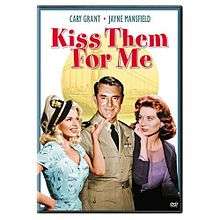Kiss Them for Me (film)
| Kiss Them for Me | |
|---|---|
 DVD cover of the film | |
| Directed by | Stanley Donen |
| Produced by | Jerry Wald |
| Written by | Luther Davis |
| Screenplay by |
Julius J. Epstein Frederic Wakeman |
| Based on | Kiss Them for Me (play) |
| Starring |
Cary Grant Jayne Mansfield Ray Walston Suzy Parker Werner Klemperer Leif Erickson Larry Blyden |
| Music by |
Lionel Newman Cyril J. Mockridge |
| Cinematography | Milton R. Krasner |
| Edited by | Robert L. Simpson |
Production company |
Jerry Wald Productions |
| Distributed by | Twentieth Century-Fox Film Corporation |
Release dates |
|
Running time | 105 minutes |
| Country | United States |
| Language | English |
| Budget | $1,945,000[1] |
| Box office | $1,800,000 (US rentals)[2] |
Kiss Them for Me is a 1957 20th Century-Fox comedy film directed by Stanley Donen.[3] As an adaptation of the 1945 Broadway play of the same name,[4] the film stars Cary Grant and Jayne Mansfield, and co-stars Ray Walston, Werner Klemperer, Leif Erickson, Larry Blyden, and introduces model-turned-actress Suzy Parker[3] in her first major film role.
Plot
Three decorated Navy pilots finagle a four-day leave in San Francisco. They land a posh suite at The Fairmont San Francisco Hotel where Commander Andy Crewson (Cary Grant), a master of procurement, arranges to populate it with wine, women and song.[5]
Blonde bombshell Alice Kratzner (Jayne Mansfield) is one of these women, lured to the suite under the false pretense that Crewson has a stash of nylon stockings. Once there, she is naturally attracted to Crewson, but later turns her attention to Lieutenant McCann (Ray Walston), a married man who also is in the process of running for a Congressional seat back home in Massachusetts. If he is elected, McCann can leave the Navy immediately and return to civilian life.
Lieutenant Wallace (Werner Klemperer) tries to get the three pilots, including "Mississip'" (Larry Blyden), to make morale-raising speeches at the plants of shipyard magnate Eddie Turnbill (Leif Erickson), so that Turnbill will vouch for the men with the Navy and also to grease a lucrative job for himself upon leaving the service. Crewson and his cohorts, however, are physically and mentally exhausted from the war and simply want to enjoy a few days away from it.
Suffering from combat stress and confronted with a number of reminders of the horrors of war, Crewson tries to amuse himself by making a play for Turnbill's attractive fiancée, Gwinneth Livingston (Suzy Parker). She resists his advances at first, but ultimately throws her engagement ring in Turnbill's face. Crewson declares his love for her shortly before he and his mates board a plane leaving San Francisco to return to duty.
Cast
- Cary Grant as Lieutenant Commander Andy Crewson
- Jayne Mansfield as Alice Kratzner
- Leif Erickson as Eddie Turnbill
- Suzy Parker as Gwinneth Livingstone
- Ray Walston as Lieutenant McCann
- Larry Blyden as Mississip
- Nathaniel Frey as Chief Petty Officer Ruddle
- Werner Klemperer as Lieutenant Walter Wallace
- Jack Mullaney as Ens. Lewis
- Kathleen Freeman as Nurse Wilinski
- Harry Carey, Jr. as Lt. Chuck Roundtree
- Maudie Prickett as Chief Nurse
- Richard Deacon as Bill Hotchkiss
- Frank Nelson as Hotel Manager R.L. Nielson
Reception
When released in late 1957, Kiss Them for Me was greeted with negative reviews. Critics called the film "vapid" and "ill-advised"; not to mention "no good". When the film didn't regain its production costs, Twentieth Century-Fox appeared to punish cast members, especially Jayne Mansfield, whose career was tossed on the back burner by the studio. Mansfield was resilient, however, and after several more years of starring roles landed on the Top 10 list of Box Office Attractions for 1963.
Kiss Them for Me was also the first film for actor Ray Walston, launching a long career.
In popular culture
The English band Siouxsie and the Banshees used the movie's name in the title and lyrics of their 1991 release "Kiss Them for Me". The song is an ode to Jayne Mansfield and her death while driving from Biloxi to New Orleans in 1967.
See also
References
- ↑ Aubrey Solomon, Twentieth Century Fox: A Corporate and Financial History, Scarecrow Press, 1989 p250
- ↑ Aubrey Solomon, Twentieth Century Fox: A Corporate and Financial History, Scarecrow Press, 1989 p227
- 1 2 "Kiss Them for Me". Turner Classic Movies. Atlanta: Turner Broadcasting System (Time Warner). Retrieved September 5, 2016.
- ↑ LIFE 1945, p. 62.
- ↑ http://www.tcm.com/tcmdb/title/80435/Kiss-Them-for-Me/
Sources
- "Kiss Them for Me". LIFE. United States: Time Inc. April 23, 1945. p. 62.
External links
At the end of the film, USS Boxer (CV-21), an Essex Class aircraft carrier, can be seen launching a Douglas A-1 Skyraider type aircraft. (The Skyraider type was not actually used in World War II.)
External links
- Kiss Them for Me at the Internet Movie Database
- Kiss Them for Me at AllMovie
- Kiss Them for Me at the TCM Movie Database